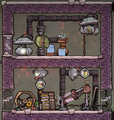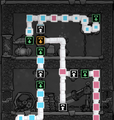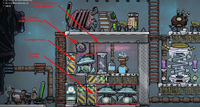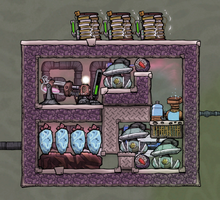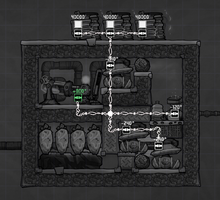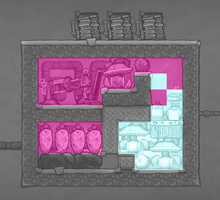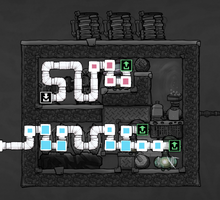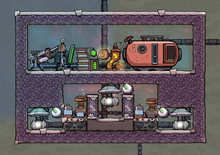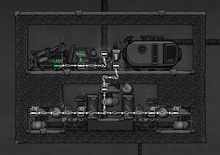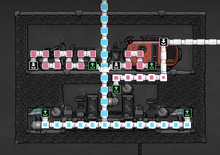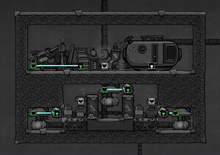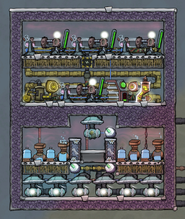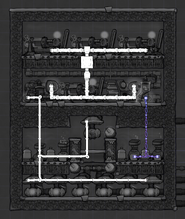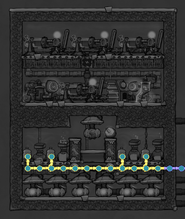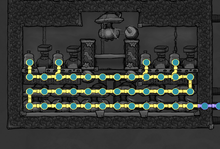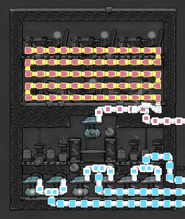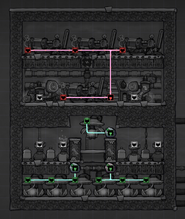Guide/Self-Powering Oxygen Machine
A Self-Powering Oxygen Machine (SPOM) is an engineering construct which produces Oxygen as well as additional power which is used to support it.
The Elements
- The key element is the Electrolyzer, which consumes water and produces Oxygen and Hydrogen.
- Gas Pumps are used to siphon both gases out; at least two are needed per Electrolyzer or it will be constantly overpressured.
- One or multiple Hydrogen Generators are used to convert the Hydrogen into Power.
- Gas separation is done either by using a Gas Filter or by utilizing the fact that Hydrogen is less dense than Oxygen (i.e. it rises up).
- A kickstart and reserve generator, e.g. a Coal Generator, Manual Generator.
- Some kind of cooling to prevent the Electrolyzer(s) and the Hydrogen Generator(s) from overheating, such as an Anti Entropy Thermo-Nullifier or a bunch of Wheezeworts. Cooling is typically not needed if all elements are made of Gold Amalgam; the SPOM can then be self-cooled.
Tips
- Geysers are a renewable source of water that can often easily support a SPOM. Use the Geyser Calculator to easily find out how much water one produces and how many Electrolyzers it can support. Note that Salt Water needs to go through a Desalinator first, which outputs only 93% of its intake Salt Water mass as Water. ( (4650g/s) / (5000g/s) = 0.93 = 93%)
- Due to the high output temperature of Oxygen of an Electrolyzer (70+ °C), it is a good idea to cool the produced Oxygen before releasing it into a base. Coolers typically use a Steam Turbine - Thermo Aquatuner heat deletion device.
- As an alternative non-permanent solution, the SPOM can be built in or near a cold biome with radiant pipes running through that biome before piping to the base.
- Some SPOMs produce excess Hydrogen, which can be used as an auxiliary power source or to power an Anti-Entropy Thermo-Nullifier.
Simple setup
The simple setup uses two Gas Pumps and filters out Hydrogen with a Gas Filter. It occasionally needs a power injection; the Hydrogen Generator cannot power it by itself. Buildings in the upper chamber will overheat if not made from Gold Amalgam. It will also leak heat through the Manual Airlock and the Pneumatic Doors.
Basic SPOM
An efficient, basic, self-filtering SPOM.
The initial startup will pump the wrong element, which will cause damage to the hydrogen generator. Under most circumstances, this will quickly set itself up to only have the correct gasses pump.
The primary benefit of this design is that all components run under a single 1k wire. It also produces a small amount of excess hydrogen, which allows for external power usage.
Setup with an environmental gas filter
A more complex setup is to use three Gas Pumps: two for the Oxygen and one for the Hydrogen and exploits the fact that the tile can hold only one type of gas at the same time.[1] Additionally it uses an Atmo Sensor to extract only some part of hydrogen and maintain enough pressure so that no oxygen passes the filter. The empirical best value for the Atmo Sensor is Activate if above 600 g.
Besides being more difficult, more expensive and having more complicated maintenance this setup also requires a 'purging' phase to start proper separation. Also, even in the normal working mode it lets a bit of hydrogen into the oxygen pipe (be aware of that if you plan to use it for Atmo Suits). However, once it's been installed, it works perfectly, netting 600-650 kg of oxygen per cycle, sometimes more.
It is also possible to build this with Insulated Tiles instead of regular Tiles and Metal Tiles. However, this machine will then leak heat from the Mechanized Airlocks and buildings will have to be constructed from Gold Amalgam to prevent overheating.
Common Designs
SPOM
| "Self-Powering Oxygen Module" by QuQuasar | |
|---|---|
| 888 g/s | |
| 112 g/s | |
| Self-Cooled? | No |
| Operating Temperature |
Low |
| Cheap Material Options? |
Yes |
| Efficiency | Medium |
This design[2] uses a single electrolyzer with a gas hood, utilizing the one-element-per-tile rule to filter hydrogen into the upper hood area, with atmo sensors to maintain certain levels of gas pressure in the system. It is capable of producing 888 g/s of oxygen.
This design may have been one of the first SPOMs ever created; it is certainly one of the first popular designs for an SPOM. While it is only named "the SPOM", here "SPOM" stood for Self-Powering Oxygen Module.
The original design of this SPOM used four Wheezeworts planted in Flower Pots (which is no longer possible) to provide cooling. Wheezeworts have been re-balanced long since; the example depicted above uses four wild Wheezeworts, based on an implementation showcased by Francis John on Youtube[3], which (in Hydrogen gas) is theoretically enough cooling for the entire setup, Jumbo Batteries included, although cooling efficiency is limited somewhat by material choices, Tempshift Plate placements, and so on; see Wheezewort for details on their cooling capabilities. Domesticated Wheezeworts provide more cooling, but require duplicant access; this is viable, since the Wheezewort section is atmospherically isolated from the actual SPOM itself, so if Airlocks and/or Liquid Locks are put in place to keep the hydrogen in the Wheezewort room, duplicants should be able to easily access it.
This design can use budget materials and still work: Granite can be used for piping and tempshift plates, Copper Ore can be used for the machinery, Copper for metal tiles, and even Igneous Rock for the insulated tiles (although some heat will likely leak into its surroundings). However, if not enough Wheezewort cooling is provided, then its machines may overheat.
Unusually, this design was intended for use specifically with three Jumbo Batteries - its creator notes that if a single Smart Battery is used instead, excess power can be generated and utilized - but there will be an excess of hydrogen gas, which must be transported away somewhere or else the SPOM will break down.
The lower atmo sensor is set to Above 500 g; the upper sensor is set to Above 1000 g.
Half Rodriguez
| "Half Rodriguez" by Francis John | |
|---|---|
| 1000 g/s | |
| ≈ 126 g/s | |
| Self-Cooled? | Yes |
| Operating Temperature |
Over 75 °C |
| Cheap Material Options? |
Limited |
| Efficiency | Low |
The "Half Rodriguez" design[3], a smaller variant of the full Rodriguez design, uses the same concepts as QuQuasar's SPOM (above), but expanded and optimized slightly. Its advantages over the latter are that it is self-cooling (requiring no Wheezeworts or external cooling sources), can produce an entire 1000 g/s of oxygen due to utilizing two electrolyzers (versus the awkward 888 g/s of the "SPOM"), and can fit inside a common four-tile-high room (unlike its big brother).
This design is not an extremely efficient setup, but has become popular as a small, self-contained module. Its machines (especially the Hydrogen Generator) should be made out of Gold / Gold Amalgam (or better), since their operating temperatures will be close to (and probably a bit over) 70 °C - assuming the input water is no hotter than 70 °C, of course. The hydrogen is used first to cool the hydrogen generator (and smart battery and Power Transformer), then the extra hydrogen can be easily stored and transported elsewhere. Granite is used for the pipes here: although Radiant Gas Pipes can be used instead for the pipes crossing the hydrogen generator/battery/transformer, they are not required.
The lower atmo sensors are set to Above 450 g; the upper sensor is set to Above 750 g. Be sure to set the low threshold of the Smart Battery above zero, to avoid blackouts (e.g. High Threshold: 90, Low Threshold: 10).
Rodriguez
| "Rodriguez" by (Unknown)[4] | |
|---|---|
| 3000 g/s[5] | |
| ≈ 378 g/s | |
| Self-Cooled? | Yes |
| Operating Temperature |
Over 75 °C |
| Cheap Material Options? |
Limited |
| Efficiency | Low |
The "Rodriguez", also known as the "Full Rodriguez"[3] (especially to contrast it with its smaller brother), is a much larger SPOM designed to support roughly 30 duplicants. It is another self-cooling design, capable of producing 3000 g/s of oxygen by using a total of four electrolyzers.
This design is not an extremely efficient setup, but has become popular as a self-contained module for larger, more-populated colonies; it is generally considered overkill for colonies with only a dozen duplicants. Its machines (especially the Hydrogen Generators) should be made out of Gold / Gold Amalgam (or better), since their operating temperatures will be close to (and probably a bit over) 70 °C - assuming the input water is no hotter than 70 °C, of course. The hydrogen is used first to cool the hydrogen generators (and the smart battery and the power transformers), then the extra hydrogen can be easily stored and transported elsewhere. Due to the larger number of heat-generating machinery in its power section, Radiant Gas Pipes are used in this example for the self-cooling hydrogen pipeline to better facilitate heat transfer, but strictly-speaking, this is optional: as long as the machines in the power section do not overheat at 75 °C, even regular Gas Pipes made of Granite are perfectly capable of self-cooling the module indefinitely. (If radiant gas pipes are desired, it is important to note that some material choices are deceptively bad: gold amalgam is especially poor, barely beating granite gas pipes.)
Unlike the smaller designs, Radiant Liquid Pipes are used here to provide additional self-cooling for the electrolyzer section: if the water supplied is lower than 70 °C, it will absorb some heat from the lower section, which will then be destroyed as the water is electrolyzed into 70 °C gases. This also cools the oxygen (and hydrogen), reducing the need for further cooling of the oxygen before it can be used by duplicants. This effect can be increased by snaking the radiant liquid pipes throughout the lower section, in a similar fashion to the radiant gas pipes in the upper section; refer to the pictures above for an example of such an arrangement.
The lower atmo sensors are set to Above 450 g; the upper sensor is set to Above 750 g. Be sure to set the low threshold of the Smart Battery above zero, to avoid blackouts (e.g. High Threshold: 90, Low Threshold: 10).
Hydra (High-Efficiency Designs)
The Hydra is an advanced class of oxygen machine which boasts higher efficiency than most of the above designs. While not necessarily self-powered in design, the hydrogen they produce can be used to generate power for them to operate on, thus turning them into SPOMs.
The high efficiency comes from taking advantage of the One element per cell rule: Electrolyzers work by outputting gas (alternating between hydrogen and oxygen) in their top-left tile. But since a single tile can only hold either liquid or gas, then if the electrolyzer (and especially its top-left corner) is submerged in liquid, its gas outputs will be immediately forced out of the top-left tile and into neighboring tiles. Also, since the electrolyzer only checks for gas pressure (not liquid) and only in its top-left tile, this means that a submerged electrolyzer can be kept running at 100% uptime - never overpressurizing, since its outputs are instantaneously evacuated from its Cell of Interest. Thus, a Hydra design will tend to have a higher oxygen/hydrogen output than a similarly-sized non-Hydra design.
See Guide/Hydra for details.
Notes
- The "efficiency" of an oxygen machine is determined by several factors: the uptime (i.e active-vs-inactive ratio) of its electrolyzer(s), whether or not its electrolyzers are capable of overpressurizing during normal operation, and whether any gas is deleted during operation (and how much). Additional limiting factors can reduce efficiency, such as how the system behaves if one (or more) or its outputs are backed up (the Rodriguez family of SPOMs are especially vulnerable to this: if backed up, gases can enter the wrong gas pumps).
References
- ↑ Video guide, Quality of Life Update Mk 1 Version
- ↑ Self-Powering Oxygen Module MkII - (Production-And-Cooling) (the original design by QuQuasar)]
- ↑ 3.0 3.1 3.2 Electrolyzer, SPOM, O2, Oxygen: Tutorial nuggets : Oxygen not included by Francis John: a guide on how to build SPOMs, showcasing several different designs and concepts
- ↑ The Rodriguez was named by Francis John after Nicolás Rodriguez, who had sent the design to him. Rodriguez probably did not design it; its exact authorship is apparently unknown.
- ↑ The Rodriguez is commonly cited as producing 2,975 g/s of oxygen, including in the above-referenced Francis John video, but rebalancing and bug fixes seem to have increased this since it was popularized; while still probably not always a consistent 3000 g/s (especially after reloading), it is very close.

